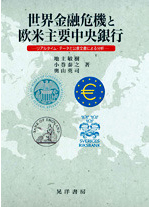Top>Opinion>Evaluating Monetary Policy and Prudence Policy by using Real-Time Data
 Index
Index

Eiji Okuyama [profile]
Evaluating Monetary Policy and Prudence Policy by using Real-Time Data
Eiji Okuyama
Associate Professor, Faculty of Commerce, Chuo University
Area of Specialization: Finance, and in particular, research on financial institutions and securities markets
1. Policy and real-time data
Real-time data are those which are available at the time of decision-making. Generally speaking, economic data are usually revised when new information is obtained afterwards; as a result, an evaluation may differ substantially if one looks back at the decision-making point based on the final data, which may have been acquired after the decision was made.
For instance, in the U.S., release of economic indicators is quite early - they become available basically in 15 days after the end of the month in question, except for those related to GDP. In contrast, in the U.K., although release of price related indicators is early, those related to the real economy take 30 to 60 days to be released. In addition, a meeting to decide on monetary policy (FOMC in the U.S, and the Monetary Policy Committee in the U.K.) is held eight times per year in the U.S., while it is held early every month in the U.K. Because of these differences in the timing of data release and meeting schedules, available data for decision-making on monetary policy differ between the two countries. The U.S. FOMC can use economic indicators which are one or two months old, while the U.K. Monetary Policy Committee can only use those which are two or three months old.
Since the available data at the time of decision making are different, without fully considering them, we may end up evaluating the policy based on data which were not available at the time of decision making. Therefore, it is necessary to evaluate monetary policy and prudence policy based on real-time data.
In the following, for the global financial crisis that began with the bursting of the U.S. housing bubble, in the period from January 2007 until December 2009, I will explain the difference produced by conducting analysis based on real-time data and based on final data, as well as providing a policy evaluation using real-time data regarding the results of analysis (for details, please refer to [1]).
2. The economic situation before and after the global financial crisis
The real-time data on GDP growth rates show that the U.S. economy entered a recession in 2007 while economic activities in Europe basically remained steady until the end of 2007. On the other hand, if we look back at the situation at the time based on the final data of GDP growth rates, we can judge that global depression started at the beginning of 2008.
The depth of economic downfall in the financial crisis is also evaluated quite differently in terms of the GDP gap (the difference between the potential output level of the economy and the actual demand) depending on the data used. The real-time data indicates that the U.S. and European countries had been on a trend of moderate economic slowdown since 2007 and that the pace of decline accelerated due to the downturn which followed the bankruptcy of the Lehman Brothers (in September 2008). However, an evaluation based on the final data shows that economic activities remained steady until the bankruptcy of the Lehman Brothers, but deteriorated sharply and simultaneously with the downturn that followed.
3. Evaluation of monetary policy and prudence policy before and after the global financial crisis
Focusing on the period just before the bankruptcy of the Lehman Brothers, monetary easing was suspended in the U.S. and the U.K., while this was also the final stage of interest rate increases in the Euro-zone. As a recession was starting in the U.S. and the U.K., their policy of suspending monetary easing may appear strange. However, theoretically estimated interest rates based on the real-time data were higher than the actual policy interest rates. In this period, as higher inflation rates due to the rise in oil and commodity prices, etc. were important, the U.S. and the U.K. can be seen to have adopted the policy in response to these.
Regarding prudence policy, decisions at the time can be checked by looking into their relationship with real-time data as well. In the U.S., no new measure was created to support financing of financial institutions when monetary easing was suspended. The same was true of the U.K., where no bank rescues using public funds were made during the period of suspension of monetary easing. In other words, the period of monetary easing suspension was a lull in the financial market turmoil. But by evaluating it based on real-time data, we can recognize that the period of suspension of monetary easing in response to the rise in inflation coincided with the suspension of new support for and rescue of financial institutions.
4. Conclusion
In general, when we evaluate the economic environment or policy judgments in the past, we often do analysis based on the data of economic indicators corresponding to the period in question. As shown above, however, the data which are available at the time of decision making are not the same as the final data for the period in question. Accordingly, we should use real-time data in analysis, in order to conduct accurate policy evaluations.
In the U.S., the U.K., and the Euro-zone, real-time databases have been established which enable more accurate evaluations of the situation at the time. In Japan, on the other hand, a real-time database has not been sufficiently developed; in some cases, data are revised with the publication of the latest information, and past data will become unavailable. As real-time data is essential for positive analysis, development of a real-time database should be given high priority.
Moreover, for matters other than finance-related policies - corporate activities, for example - the distinction between real-time data and final data is also important, and will, in turn, presumably lead to more accurate evaluations.
Reference

- Eiji Okuyama
Associate Professor, Faculty of Commerce, Chuo University
Area of Specialization: Finance, and in particular, research on financial institutions and securities markets - Originally from Gifu Prefecture. Born in 1973.
Graduated from the Faculty of Economics, Kobe University in 1996.
Worked for the Dai-Ichi Kangyo Bank, Ltd. in 1996-1997.
Obtained a PhD in Economics from the Graduate School of Economics, Kobe University, after finishing doctoral course in comprehensive economic policy in 2003.
Became Full-time Lecturer at the School of Economics, Hokusei Gakuen University; a Full-time Lecturer and then Associate Professor at Faculty of Commerce, Chuo University, before taking up his current position in 2007.
His current research topics are research on changes in the behavior of financial institutions and risk in response to changes in financial regulations; and research on changes in the behavior of companies in response to changes in regulations and systems.
His major publications include the reference for this essay: Co-authored, Global Financial Crisis and Major Central Banks in the U.S. and Europe - Analysis based on Real-Time Data and Public Documents [Sekai-kinyukiki to oubei-shuyo-chuo-ginko - riaru-taimu deta to kohyo-bunsyo niyoru bunseki] Koyo Shobo Corporation (2012)
- Research Activities as a Member of Research Fellowship for Young Scientists (DC1), Japan Society for the Promotion of Science (JSPS) Shuma Tsurumi
- Important Factors for Innovation in Payment Services Nobuhiko Sugiura
- Beyond the Concepts of Fellow Citizens and Foreigners— To Achieve SDGs Goal 10 “Reduce Inequality Within and Among Countries” Rika Lee
- Diary of Struggles in Cambodia Fumie Fukuoka
- How Can We Measure Learning Ability?
—Analysis of a Competency Self-Assessment Questionnaire— Yu Saito / Yoko Neha - The Making of the Movie Kirakira Megane








